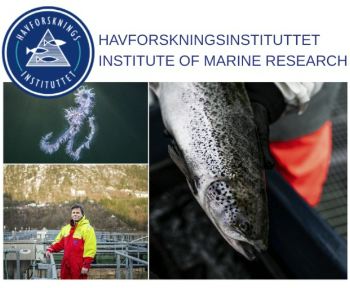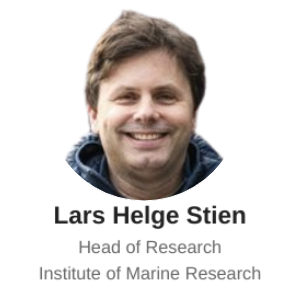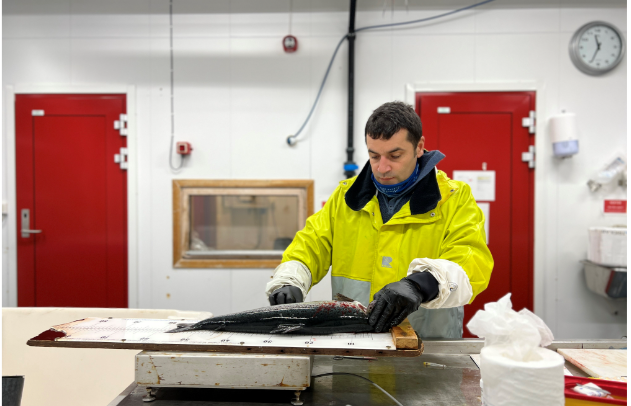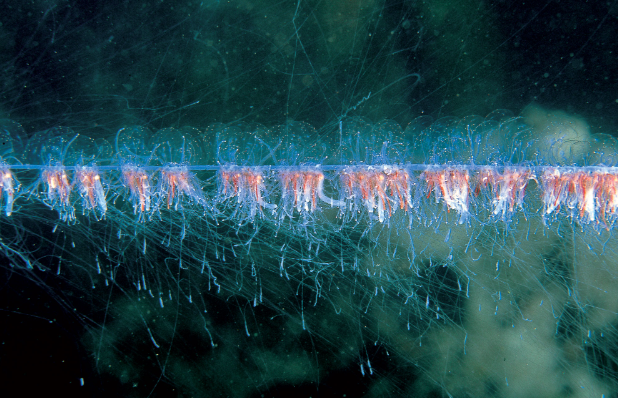|

Around 3 million fish probably died as a result of attacks from the pearl seabream in 2023. Photographer: Erling Svensen/Christine Fagerbakke/HI
65 million farmed fish died in Norwegian farms last year
 (NORWAY, 2/13/2024)
(NORWAY, 2/13/2024)
This is an increase of 7 million from the previous year. Around 3 million fish probably died as a result of attacks by the pearl shark, and many were slaughtered as mitigation measures out of concern for animal welfare.
 "When we consider the extraordinary events last year, the death toll is roughly the same as in previous years. So there was not an unusually high mortality rate last year, despite the fact that as many as 65 million farmed fish died", says HI researcher Lars Helge Stien. "When we consider the extraordinary events last year, the death toll is roughly the same as in previous years. So there was not an unusually high mortality rate last year, despite the fact that as many as 65 million farmed fish died", says HI researcher Lars Helge Stien.
He emphasizes that the mortality rate in Norwegian breeding facilities is far too high.
This is revealed in this year's edition of the Institute of Marine Research (HI)'s risk report for Norwegian fish farming.
Have assessed what extraordinary events have meant
As part of the analysis, the researchers have made an assessment of whether there was a real increase in mortality last year. Here they have taken care to ensure that there were more farmed fish in the sea last year than the year before.
"If we only consider this difference between the two years, then the mortality rate has increased", says Stien.
There were two major extraordinary events last year that affected the mortality rate of breeding facilities that were hit: attacks by pearl seabream along almost the entire coast and outbreaks of pancreatic disease (PD) in Nordland.
"If we exclude fish that were affected by these incidents, the mortality is pretty much the same as in previous years", says Stien.
Extraordinary events have become commonplace
Such major or minor extraordinary events seem to occur every year.
"It is unfortunately the case that incidents with a high mortality rate at individual facilities occur every year, and are part of the risk picture in Norwegian aquaculture", says Stien.

Angelico Madaro takes samples of farmed salmon after a jellyfish operation in the facility at the HI research station in Austevoll in November 2023. Photo: Christine Fagerbakke/HI
De-lice both damage and kill farmed fish
As in previous years, it was also necessary last year to deworm farmed fish. This is done in an attempt to reduce the infection of the parasite salmon lice on wild salmon, sea otters and char.
"This kind of infection is so dangerous for wild salmon, that it is the amount of salmon lice on them that determines growth or reduction in the farming industry", says Stien.
The breeders have different methods they can use when they have to deworm the fish. Which method is most suitable will vary based on, for example, the age of the fish and local conditions at the plant. The treatment can, among other things, consist of medication given in feed or various forms of thermal and mechanical de-lice removal.
"During both thermal and mechanical lice removal, the fish are forced into cages, pumped and sent through pipes and reed slides, in addition the treatment itself comes in hot water or various forms of flushing. This handling can be risky for the fish. Many are injured, some die immediately after treatment, others are more exposed to infections and may die or have reduced welfare in the long term", says Stien.
Jellyfish (Apolemia uvaria) killed millions of fish
Last year, many farms were hit by attacks from the pearl moth. As a result, many farmed fish died.
This jellyfish consists of a number of individuals that hang together - much like a string of pearls. Like the jellyfish, it is equipped with nettle cells that sting or burn when they come into contact with something.

Dangerous for the salmon: The jellyfish (Apolemia uvaria) killed around three million fish last year. Photo: Erling Svensen/HI
"Farmed fish that are badly affected by the pearl standard can suffer large wounds and reduced welfare. In the worst case, the wounds develop so that they die", says Stien.
At facilities that were attacked, both acute damage and damage that appeared over time were observed.
"On some fish, it takes a long time before the damage becomes visible and they develop ulcers. We therefore see that after such an attack, there may be an increase in mortality over time", says Stien.
Although there is less of the jellyfish now, it can still have consequences:
"A number of facilities were attacked in December, so it is possible that we will only see it again in terms of mortality in January this year", says Stien.
The jellyfish happened to plant differently
There seems to be a large variation in how badly the jellyfish hit the various plants that reported attacks. A lot of damage and high mortality was reported from some plants, while others were far luckier.
"In order for the salmon to be damaged by the perlesnormaneta, there must be physical contact between the jellyfish and the fish", says Stien.
It is difficult to answer exactly what made certain plants more easily escape the attack than others, but the researcher has some theories.
"Perhaps there were not such large quantities of jellyfish on the facilities that were less affected, or it may have been that measures such as lice skirts to keep the jellyfish out, or stopping the feeding to make the salmon stay deep and below the layer with the most manet, which may have helped. The health situation of the fish before the attack may also have had an impact on how well they coped with the extra stress", he says.
Author/Source: Beate Hoddevik/HI - Havforskningsinstituttet - Norwegian Institute of Marine Research
[email protected]
www.seafood.media
Information of the company:
|
Address:
|
Nordnesgaten 50, P.O. Box 1870 Nordnes
|
|
City:
|
Bergen
|
|
State/ZIP:
|
(N-5817 )
|
|
Country:
|
Norway
|
|
Phone:
|
+47 55 23 85 00
|
|
Fax:
|
+47 55 23 85 31
|
|
E-Mail:
|
[email protected]
|
More about: 
|
|
|
|



